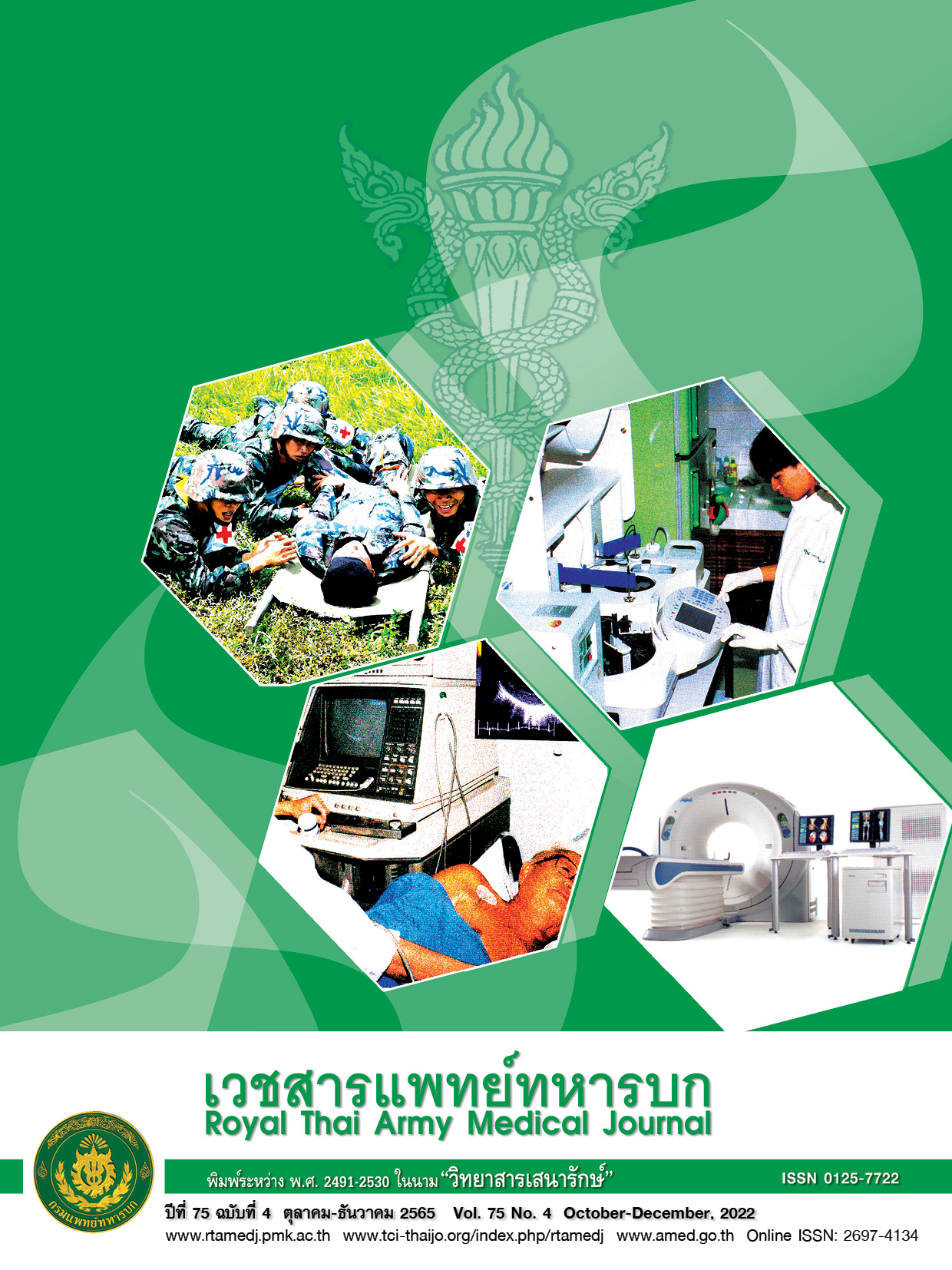รายงานกรณีผู้ป่วยกระดูกหน้าแข้งหักสี่ท่อนที่ทำการรักษาด้วยโลหะดามในแกนโพรงกระดูกและใช้อุปกรณ์หนีบหลายอัน
Main Article Content
บทคัดย่อ
กระดูกหน้าแข้งหักแบบหลายท่อนถือว่าเป็นการบาดเจ็บและมีภาวะแทรกซ้อนที่รุนแรงพบได้ไม่บ่อยในเวชปฏิบัติ การบาดเจ็บลักษณะนี้มักจะมีสาเหตุจากการบาดเจ็บที่มีพลังงานสูง สัมพันธ์กับการบาดเจ็บของเนื้อเยื่อที่มาก ทำให้กระดูกนั้นขาดเลือดมาเลี้ยงได้ มีโอกาสที่จะเกิดภาวะแทรกซ้อนได้ในระหว่างที่ทำการผ่าตัด และเกิดการบิดหมุนของกระดูกแต่ละชิ้นได้ระหว่างทำการผ่าตัดขยายแกนโพรงกระดูก รายงานนี้เป็นกรณีผู้ป่วยชายที่มีกระดูกหน้าแข้งขวาหักสี่ท่อนถูกทำการรักษาด้วยการใช้อุปกรณ์หนีบกระดูกผ่านผิวหนังหลายอันเพื่อช่วยในการดึงกระดูกให้เข้าที่และตรึงกระดูกให้อยู่นิ่ง กระดูกสามารถติดได้ที่ 20 สัปดาห์ ผู้ป่วยสามารถลงน้ำหนักได้เต็มที่ ภาพฉายรังสีแสดงการติดของกระดูกที่ช่วงเวลาเดียวกัน การใช้วิธีการผ่าตัดโดยใช้อุปกรณ์หนีบกระดูกแบบหลายอันสามารถช่วยดึงกระดูกให้เข้าที่และตรึงให้อยู่กับที่ทุกท่อนช่วยป้องกันการเคลื่อนของกระดูกได้ก่อนที่จะเริ่มขยายแกนโพรงกระดูกและใส่โลหะดามในแกนโพรงกระดูก ซึ่งสามารถช่วยลดภาวะแทรกซ้อนระหว่างการผ่าตัดได้
Downloads
Article Details

อนุญาตภายใต้เงื่อนไข Creative Commons Attribution-NonCommercial-NoDerivatives 4.0 International License.
บทความในวารสารนี้อยู่ภายใต้ลิขสิทธิ์ของ กรมแพทย์ทหารบก และเผยแพร่ภายใต้สัญญาอนุญาต Creative Commons Attribution-NonCommercial-NoDerivatives 4.0 International (CC BY-NC-ND 4.0)
ท่านสามารถอ่านและใช้งานเพื่อวัตถุประสงค์ทางการศึกษา และทางวิชาการ เช่น การสอน การวิจัย หรือการอ้างอิง โดยต้องให้เครดิตอย่างเหมาะสมแก่ผู้เขียนและวารสาร
ห้ามใช้หรือแก้ไขบทความโดยไม่ได้รับอนุญาต
ข้อความที่ปรากฏในบทความเป็นความคิดเห็นของผู้เขียนเท่านั้น
ผู้เขียนเป็นผู้รับผิดชอบต่อเนื้อหาและความถูกต้องของบทความของตนอย่างเต็มที่
การนำบทความไปเผยแพร่ซ้ำในรูปแบบสาธารณะอื่นใด ต้องได้รับอนุญาตจากวารสาร
เอกสารอ้างอิง
2. Corey RM, Park NK, Cannada KL. Segmental tibia fractures: an analysis of complication and healing rates. J Orthop Trauma. 2018;32:296–300.
3. McMahon SE, Little ZE, Smith TO el al. The management of segmental tibial shaft fractures: A systematic review. Injury. 2016;47:568–573.
4. Rommens PM, Coosemans W, Broos PL. The difficult healing of segmental fractures of the tibial shaft. Arch Orthop Trauma Surg. 1989;108: 238–242.
5. Woll TS, Duwelius PJ. The segmental tibial fracture. Clin Orthop Relat Res. 1992;281:204–207.
6. Giannoudis PV, Hinsche AF, Cohen A, et al. Segmental tibial fractures: an assessment of procedures in 27 cases. Injury. 2003;34:756– 762.
7. Beardi J, Hessmann M, Hansen M, et al. Operative treatment of tibial shaft fractures: a comparison of different methods of primary stabilisation. Arch Orthop Trauma Surg. 2008;128:709–715.
8. Teraa M, Blokhuis TJ, Tang L, et al. Segmental tibial fractures: an infrequent but demanding injury. Clin Orthop Relat Res. 2013; 471:2790–2796.
9. Robertson A, Giannoudis PV, Matthews SJ. Maintaining reduction during unreamed nailing of a segmental tibial fracture: the use of a Farabeuf clamp. Injury. 2003; 34:389–39.
10. Boyd HB, Lipinski SW. Causes and treatment of nonunions of the shafts of the long bones, with a review of 741 patients. Instr Course Lect 1960;17:165–72.
11. Wu CC, Shih SH. Segmental tibial shaft fractures treated with interlocking nailing. J Orthop Trauma 1993;7:468–72.
12. Rommens PM. The significance of soft tissue trauma for fracture healing: prospective study on 70 tibial shaft fractures. Acta Chir Belg 1992;92:10–8.
13. Reynders P. Open acute segmental tibial fracture fixation using the Less Invasive Stabilisation System (LISS): Study of 23 consecutive cases. Injury. 2009;40:449–454.
14. Öztürkmen Y, Karamehmetoglu M, Karadeniz H, et al. Acute treatment of segmental tibial fractures with the Ilizarov method. Injury. 2009;40:321–326.
15. Kakar S, Tornetta P III. Segmental Tibia Fractures: a prospective evaluation. Clin Orthop Relat Res. 2007;460:196–201.
16. Hoon S, Jun Y, Hyung KS. Analysis of complications and clinical outcomes in the treatment of segmental tibial fractures according to the method of internal fixation. Asian Journal of Surgery. 2019; 42:740e745.
17. Yoon RS, Bible J, Marcus MS, et al. Outcomes following combined intramedullary nail and plate fixation for complex tibia fractures: a multi-centre study. Injury. 2015;46:1097–1101.
18. Court-Brown C, Pennig D. Tibia and fibula. Oxford, Boston, Singapore: Butter- worth-Heinemann; 1997.
19. Schütz M, Kääb MJ, Haas N. Stabilization of proximal tibial fractures with the LISS system: early clinical experiences in Berlin. Injury 2003;34:S30–5.
20. Brooks M, Revell WJ. Blood supply of bone; scientific aspects. London: Springer- Verlag; 1998.
21. Kamal B, Kumar V, Sandeep P, et al. Double segmental tibial fractures - an unusual fracture pattern. Chinese Journal of Traumatology. 2011;14(4):247-249.
22. Mateen HA, Brendan S, Elizabeth OP, et al. Does it really spin? Intra-medullary nailing of segmental tibial fractures—A cadaveric study. Injury. 2015; 46:643–648.


